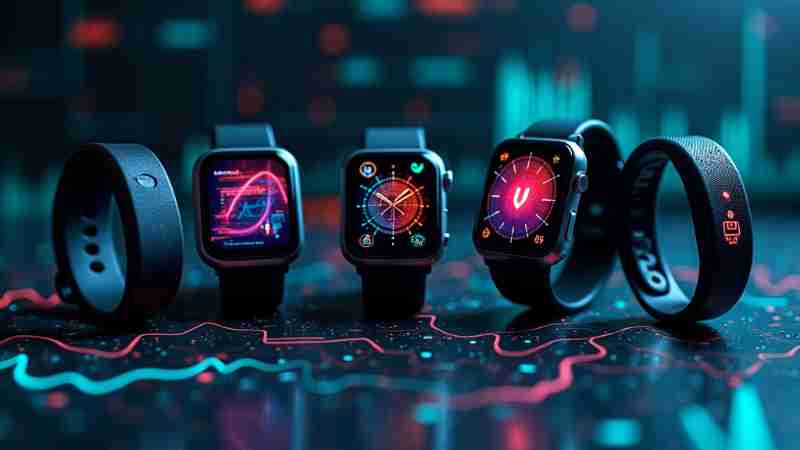Wearable technology has moved far beyond simple fitness trackers, now offering advanced tools that help users track their health, optimize workouts, and even manage stress. Brands like Oura, Apple, Fitbit, and Meta are leading the charge, developing devices that provide detailed insights into personal wellness. From improving sleep quality to enhancing focus, today’s wearables are designed to make health management more seamless and efficient.
Key Takeaways
Wearable tech is revolutionizing health and wellness by providing cutting-edge tools to track physical fitness, reduce stress, boost performance, and combine functionality with style.
- Innovative devices like the Oura Ring and Apple Watch Series 10 deliver comprehensive health insights and fit seamlessly into everyday life.
- Gadgets such as the Apollo Neuro and Muse headband help manage mental well-being with biofeedback and relaxation techniques.
- The evolution of wearable tech now includes stylish options like Ray-Ban Meta smart glasses that perfectly blend fashion with everyday functionality.
Tracking health with precision
The Oura Ring is a prime example of how wearable technology has evolved. This sleek, lightweight ring tracks sleep, activity levels, heart rate variability, and stress, providing users with a detailed overview of their overall wellness. Unlike bulky fitness watches, it offers a more discreet way to collect and analyze health data. With its long battery life and easy-to-use app, the Oura Ring is a top choice for those looking to gain deeper insights into their daily health habits.
Apple has continued to refine its smartwatch lineup with the release of the Apple Watch Series 10. More than just a fitness tracker, the latest model provides advanced health metrics, including ECG readings, blood oxygen levels, and real-time heart rate monitoring.
It also detects irregular heart rhythms and offers crash detection, which automatically alerts emergency contacts in case of an accident. With seamless integration across Apple’s ecosystem, the watch makes it easy for users to track their health and share data with medical professionals when necessary.
For those who want a screen-free experience, the WHOOP band provides an alternative approach. Unlike traditional fitness trackers, WHOOP focuses on recovery by analyzing strain, sleep, and readiness levels.
It provides personalized recommendations based on daily activity and ensures that users understand how their bodies are responding to workouts and rest. The absence of a screen means fewer distractions, making it an excellent option for athletes or anyone looking to improve performance without constant notifications.
Reducing stress and improving focus
Beyond tracking physical health, wearable technology is also being used to promote mental well-being. One of the most innovative products in this space is the Apollo Neuro, a wearable device that helps regulate the nervous system through gentle vibrations.
By stimulating pressure points, it encourages relaxation and reduces stress levels, making it particularly useful for those with anxiety or high-pressure jobs. The device can be worn on the wrist or ankle and is controlled through an app, allowing users to customize their experience based on their needs.
Another approach to stress reduction comes from the Muse headband, which is designed to enhance meditation and focus. Using real-time biofeedback, Muse helps users train their minds to stay present and relaxed. It measures brain activity and provides guided meditation sessions based on real-time data, making mindfulness more accessible to beginners and experienced meditators alike.
Enhancing performance and recovery
For fitness enthusiasts and athletes, wearables have become essential tools for optimizing performance. Fitbit’s latest offering, the Fitbit Charge 6, continues to push the boundaries of fitness tracking with improved heart rate accuracy, built-in GPS, and recovery insights. The device not only tracks daily activity but also provides exercise recommendations based on recovery levels, ensuring that users don’t overtrain.
Similarly, WHOOP has gained popularity among serious athletes due to its ability to analyze strain and recovery in detail. The subscription-based wearable collects data on heart rate variability, sleep cycles, and daily exertion, giving users insights into when they should push harder or take a rest day. By focusing on recovery rather than just activity, WHOOP helps users maximize performance while avoiding burnout.
For those who enjoy outdoor sports, Garmin’s line of smartwatches offers specialized tracking features. Whether it’s monitoring altitude, tracking runs with precision GPS, or providing insights into hydration levels, Garmin devices cater to athletes who need more than just basic step counts and calorie tracking.
Merging technology with fashion
As wearable tech becomes more advanced, brands are integrating functionality with style. The Ray-Ban Meta smart glasses are a perfect example of how fashion and technology can coexist. These high-tech glasses allow users to take hands-free calls, access voice assistance, and even capture videos—all while maintaining the classic Ray-Ban design. Ideal for busy professionals or travelers, they offer a seamless way to stay connected without constantly looking at a phone.
The Oura Ring also strikes a balance between aesthetics and functionality. Unlike traditional fitness watches, which can be bulky, the ring offers an elegant alternative for those who prefer minimalistic wearables. Available in various finishes, it blends seamlessly with everyday accessories while still providing comprehensive health data.
Similarly, Apple’s recent collaborations with luxury brands have brought more stylish smartwatch options to the market. With premium bands and customizable watch faces, users can personalize their devices without sacrificing sophistication.
The future of wearable technology
Wearables are advancing with non-invasive blood glucose monitoring, AI-driven health insights, and deeper integration with medical care. Smartwatches may soon track blood sugar without finger pricks, while AI will personalize health recommendations based on real-time data. Doctors could access wearable data for better treatment, and smart fabrics may replace traditional devices for seamless tracking. As these innovations unfold, wearable technology will play an even greater role in daily health management.
As technology continues to evolve, these devices will play an increasingly critical role in helping people live healthier, more informed lives.






